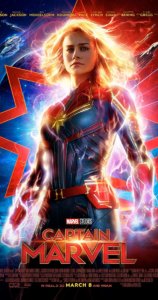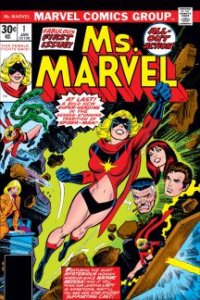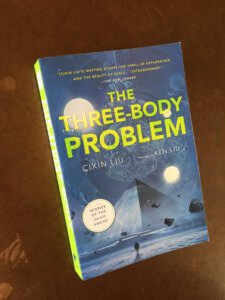Family Friendly
CAPTAIN MARVEL: Female Empowerment and the Superhero
A REVIEW OF THE 2019 FILM AND A FEW OTHER OBSERVATIONS
In the last ten years, the urging of audiences around the globe have pushed the film industry to re-think the way it portrays people of color and women, folks who might not have been featured in stories (especially superhero stories) as headliners.
A number of different types of heroes have emerged victorious: Wonder Woman hit the scene big in 2017, the Black Widow in the Marvel universe has taken an elevated seat (will not spoil, but she plays an essential roll in Avengers: End Game, released this past month), and Black Panther, another Marvel character and storyline that incorporates not only one African character, but an entire culture.
All those films/characters broke open that hunger into full fledged box office $ and now, CAPTAIN MARVEL enters the scene.
Captain Marvel. First of all…I have to say. What fun! I loved this film and I noticed after emerging from the fog of the fictional dream what the credits indicated. I noticed how many women worked on the writing. The WRITING. I cannot emphasize this enough. Women were put into positions of power, able to make decisions about the story.
- Directed by Anna Boden
- Screenplay written by Anna Boden and a dude named Ryan
- Story credits going to Anna Boden, Nicole Perlman, Geneva Roberson-Dworet, Meg Le Fauve, and yes…a dude named Ryan
So…when there was a shouting match in the writer’s room about what the character is thinking and feeling and the actions she is about to take…Ryan might have been “out-shouted” by the women. That was a good thing for audiences everywhere.
Wonder Woman was an amazing film, but women were not in the writing credits. A woman was instrumental in the direction of the film, which is awesome, but women did not “create the character”. Here are the names of the writers:
- Zach Snyder
- Alan Heinberg
- Jason Fuchs
I’m not saying these dudes were bad people, insensitive to female motivation and feminine issues of power and agency, but…they are three dudes and there are zero women in terms of the story creation.
What was it like to be in the writer’s room of CAPTAIN MARVEL versus Wonder Woman. I imagine there was a difference.
And for me, even before I saw the credits, CAPTAIN MARVEL struck a note about women differently than Wonder Woman did. I noticed how the character’s strengths and flaws made sense to me as a woman.
CAPTAIN MARVEL was not a perfect film and there are problems (as an author I foresee them) with how incredibly powerful the creators have made Carol “Captain Marvel”. What is to keep her from showing up every other day and solving the world’s issues? The implication from Avengers: End Game is that she is super dang busy with solving the universe’s problems, so she can’t bail us out every time Earth has an issue.
A problem a lot of great woman face, I suppose. They want to help people, but have too much to do and not enough time on their hands…CAPTAIN MARVEL sounds like any number of Saints in the Catholic Canon. “If there were just more of us…” said one lady saint to another…
Indeed…I hope there will be more female heroes portrayed in the superhero universe in the coming years.
By the way…for those interested…there is a weird subtext to the Wonder Woman mythology. Click here to read an article about the man who conceived of the character: The Creepy Creator of Wonder Woman
But don’t discount this creator/writer too quickly. He is said to have written this in a letter to the publishers of DC Comics:
“Look, if you had a female superhero, her powers could all be about love and truth and beauty, and you could also sell your comic books better to girls,” he said. “And that would be really important and great because she could show girls that they (girls) could do anything.”
DESCENDER by Jeff Lemire and Dustin Nguyen, A Review of Volume 1, TIN STARS

Here’s the review of VOLUME 1: TIN STARS
First, my pure recommendation…YES! You ought to read TIN STARS. Here’s why:
- The Story is Fantastic (and volume 1 is a great set up for more drama)
- The Art is to Die For
- The Characters Feel True and Interesting
- The World is Fantastically Drawn (in the art and in the narrative)
Jeff Lemire and Dustin Nguyen team up to create a beautiful and gripping story. Due to language and some graphic violence, I rate the novel overall PG-13.
If you hunger for A.I. and space and aliens of various types, shapes and forms, they all inhabit this place. Also, the graphic novel format feels like a window into the future. What the author does not describe in words, we see on the page, beautifully drawn and colored by Nguyen (what a talent!). The graphic novel genre lends itself well to the world of a future civilization, something beyond our imagination and fantastical. The author, Lemire, also knows how to build tension and keep his audience gripped and turning pages.
Speaking of turning pages, I found (after I had read the first volume) this handy reference page, called: Atlas of the Core Planets of the the United Galactic Council. The world imagined by Lemire is complex physically and politically. Each planet has a unique character, so I can see why the author saw the value in adding it.
This page was not present in volume 5, perhaps Lemire assumes we know the world by then, but it is at the end of 1-4. It’s helpful, especially if you’re the type who likes to know the world well before you read the story, flip to the back right away to orient yourself.
Don’t be surprised to see this series come to the screen sometime in the near future. When that happens, you can breathe on your fingertips, wipe them on your cuff and brag…Oh yes, I read the graphic novels, back in 2019.
To order your copy, click here: DESCENDER, Volume 1, Tin Stars
To order your copy of
ARRIVAL, Film Review Without Spoilers

ARRIVAL is rated PG 13…it’s somewhat creepy and suspenseful, but a middle school child or a sensitive viewer could probably handle the production. I’m not sure why it did not receive the PG rating. It unfolds without graphic violence and there is no explicit sexual content. One might call ARRIVAL a quiet film, but the subject matter takes it from the quiet realm into the epic and deeply thoughtful.
ARRIVAL was released in theaters to much acclaim in 2016. The film is based on a short story by Ted Chiang. Eric Heisserer wrote the screenplay. I hope to read and review Chiang’s short story in a future post.
The film unfolds with slow intensity primarily around one character, Louise Banks, played wonderfully by Amy Adams. Banks is a linguist recruited by the US government to learn the language spoken by aliens who have alighted in giant oblong space ships in twelve locations around the globe.
The story is a linguist’s dream and as a science fiction fan, I recall a number of novels that view first contact in light of language and communication. China Miéville’s Embassy Town is a good example. In a story such as this, violence is often threatened, but not center stage. Mysteries and the push to understand the other dominate the narrative.
Five quotes from the screenplay to pique your interest:
- “If this is some sort of peaceful first contact, why send twelve? Why not just send one?”
- “Language is the first weapon drawn in a conflict…”
- “Are they scientists or tourists? If they’re scientist, they don’t seem to ask a lot of questions…”
- “If you could see your life from start to finish, would you change things?”
- “Meeting you…was more important that seeing the stars…”
Five reasons to watch this film.
- It’s free if you’re an Amazon Prime member.
- If your family is into science fiction, ARRIVAL is a crowd pleaser which you can show to your kids with a clear conscience.
- Lots to ponder about language and linguistics, language and meaning, the puzzle and the importance of communication.
- Female hero with lots of brains and only a few characters to keep track of.
- Potentially leads to fruitful discussion about love, suffering, beauty, grace, even religion.
To buy this DVD, click here.
The Phantom Tollbooth, Twenty Possible Discussion Questions for Educators
The art of a good question is always to draw out the thoughts and feelings of the one being questioned…(and for the most part…to avoid yes/no answers).

To read a review of THE PHANTOM TOLLBOOTH, click here
To order THE PHANTOM TOLLBOOTH, click here.
- What is Milo like in Chapter 1. How would you describe him?
- Would you want to be Milo’s friend, the Milo of Chapter 1? Why or Why not?
- When Milo sees the mysterious gift, he makes a pretty big effort to put it together (the tollbooth) and then decides to use it. Does this surprise you? Why or Why not? Would you go through all the trouble to put the tollbooth together and use it?
- In Milo’s initial travels, he gets stuck in the Doldrums. Who helps him get out? What does Milo have to do to get his car moving again?
- How would you describe Dictionopolis?
- In chapter 6, we learn about two Princesses. What are their names and how did they get banished?
- Milo starts thinking about the idea that he will rescue the Princesses. Where are the Princesses being held and what hardships will Milo face if he tries to rescue them?
- How would you describe the banquet in Dictionopolis? Did any of the foods make you laugh? Which one(s)?
- Chapter 9 introduces us to a boy called Alec and the idea of Point of View…How would you define “point of view” based on the discussion Alec and Milo have?
- In Chapter 10, the chapter that features Reality, Milo realizes “…the many times he’d done the very same thing; and, as hard as he tried, there were even things on his own street that he couldn’t remember…” What was Milo’s mistake? How has he made the same mistake people in Reality made long ago?
- Alec tells Milo in Chapter 11: There’s a lot to see everywhere, if only you keep your eyes open. What do you think Alec means when he says this to Milo? What is Milo supposed to see?
- Are noises and sounds important to you? Which ones and why? What do you think it would be like to live in a place where there was no sound?
- Milo steals a sound from the Soundkeeper…How does he do it and what are the results?
- Is the Island of Conclusions a good place to jump to? Why or why not?
- Who helps Milo reaches Digitopolis (see Chapter 14)?
- How does Milo outsmart the Mathemagician?
- What does the Demon of Petty Tasks and Worthless Jobs, Ogre of Wasted Effort and Monster of Habit ask Milo, Humbug and Tock to do?
- What are the demons that protect Ignorance? Come up with a list of the demons in this book, to the best of your ability (hint…end of Chapter 16 to middle of chapter 19)
- Which demon scares you the most and why?
- Look back to your Chapter 1 answer…How has Milo learned from his adventure? How would you describe him now? Would you want to be Milo’s friend, the Milo of Chapter 20?
THE THREE BODY PROBLEM: For Educators
Worthy of a Physics/Calculus Teacher’s Attention particularly high school and particularly for AP or IB Physics students
ALSO instructive for discussions in philosophy and ethics (see bottom paragraph)
High school physics instructors or calculus instructors…this novel would make a great summer reading assignment before your class begins in the Fall. One, the story is entertaining. Two, the story portrays historically some of the greatest physicists to walk planet Earth. Three, The Three Body Problem itself, the actual physics problem, this engages the physicist’s and the mathematician’s mind, Newtonian physics and all that jazz…Not that I understand it all, but I believe these the guys who write on the website: askamathematician.com. The excerpt below is from their website
The Three Body Problem is to exactly solve for the motions of three (or more) bodies interacting through an inverse square force (which includes gravitational and electrical attraction).
The problem with the 3-body problem is that it can’t be done, except in a very small set of frankly goofy scenarios (like identical planets following identical orbits).
The unsolvability of the 3-body problem, rather than being an embarrassing hole in physics, an obvious but unsolved problem, is actually the norm. In physics, the number of not-baby-simple, exactly solvable problems can be counted on the fingers of one hand (that’s missing some fingers), and that includes the 2-body problem.
The dynamics of one body is pretty straight forward, in as much as it travels straight forward.
The dynamics of two bodies, while not trivial, can be reduced by pretending that one body is sitting still, and then restricting all of your attention to the other body. Using that technique, you find (or, at least, Newton found) that the motion of a body under gravity is an ellipse. The same idea can be applied to the quantum mechanics of electrons and protons to find the exact structure of the electron shells in hydrogen (1 proton + 1 electron = 2 bodies). In that case you’re not talking about actual orbits, but the idea is similar.
But, for three bodies, there doesn’t seem to be a fancy trick for finding solutions. As a result, the exact behavior of 3 or more bodies can’t be written down. The exact energy levels and orbital shell shapes in anything other than hydrogen is impossible to find. Even deuterium (hydrogen with one extra neutron)! Can’t be done.
Despite that, we do alright, and happily, reality doesn’t concern itself with doing math, it just kinda “does”. For example, quantum field theory, despite being the most accurate theory that ever there was, never involves exactly solving anything. Once a physicist gets a hold of all the appropriate equations and a big computer, they can start approximating things. With enough computing power and time, these approximations can be made amazingly good. Computer simulation and approximation is a whole science unto itself.
The main actors in THE THREE BODY PROBLEM are almost all physicists and/or mathematicians and they’re nerdy, but not dweebs. Read chapter 5, A Game of Pool if you want a taste of what the novel offers. Then, there is the virtual reality, which unfolds as a puzzle/game and is played often by nanotechnology researcher, Wang Miao. Wang is compelled to understand the mystery introduced in the early chapters of the novel and realizes that the game is key to the revelation he seeks. In the game world, Wang walks through the history of physics with virtual characters like Confucius (our earliest physicists were primarily philosophers…a helpful connection for students to make), Newton and Einstein. Trisolara happens to be grappling with the three body problem. It is a planet in a solar system where there are three suns. The game players, along with the philosophers and physicists throughout history try again and again, in a systematic way, to solve the problem of the planet’s impending destruction. To go through each game level, Wang encounters physicists who have furthered the thinking regarding the problem. It’s like taking a course called The Intro to Physics…all this learning while the reader hurtles toward the big reveal at the end of the novel. Ah…to be entertained while learning…tis a wonderful thing. At the very least, THE THREE BODY PROBLEM ought to raise the curiosity level of your students and give them a glimpse of the relevance of physics and math to their everyday lives.
For the ethicist/philosopher, THE THREE BODY PROBLEM raises interesting issues about elites thinking they know best for all. The Cultural Revolution in China drives the narrative in the early chapters. Many elites are driven out of their positions of authority, killed or exiled by the communist party as it takes power. The author calls this a madness. (Chapter 1’s title is: The Madness Years). However, within the communist party, a new breed of elites rise to the top. Later, toward the final chapters of the novel, a group of environmental activists, along with men and women Liu specifies as elites across the globe, use their power to set in motion what they hope will be Earth’s salvation (knowing that saving the planet may come at the expense of most or all human lives). This small group of people have become judge, jury and executioner for humanity. Moreover, their hope for saving the Earth might not evolve the way they imagine. The stage is set for a discussion about power, elitism, environmental degradation and what might be ways to stem our self-destructive/planet-destroying tendencies.
To read a No-Spoiler review of this novel, click THREE BODY PROBLEM, Book Review
To buy THE THREE BODY PROBLEM, click here.




